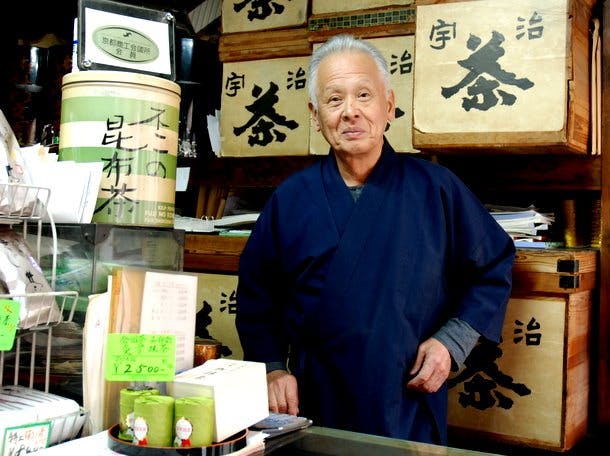
kyoto tea
Discover the secrets of Kyoto's renowned tea scene at Goshono-e, a tiny tea merchant near the Imperial Palace. Learn about the distinct flavors of hojicha and bancha, roasted green teas, and the expertise of tea merchant Mr. Motojiro Tekemura in sourcing top-quality teas directly from growers. Find out the differences in roasting styles and leaf types from this immersive experience.
During a remarkable meal at Chef Nakahigashi's revered restaurant in Kyoto a couple of years ago, he served me a cup of steaming hojicha -- roasted green tea -- that was like no hojicha I tried before. It was nutty and delicate and absolutely satisfying. "From Ippodo," I asked? Ippodo is a Kyoto-institution, a generations-old tea shop famous for its top-quality teas. No, the chef replied. He bought his hojicha from a tiny tea merchant named Goshono-e, near the Imperial Palace (I believe "gosho" means "palace" -- am I right?). I made a mental note -- okay, I wrote it down -- to check this place out on a future trip.
Now that I'm back in Kyoto I asked Nakahigashi-san's son to help me locate the shop. He graciously agreed. We found the proprietor, Mr. Motojiro Tekemura, silver-maned and dressed in a traditional indigo samue, standing before a stack of two-foot tall wooden tea chests. Mr. Tekemura has been a tea merchant for forty years; he buys his leaf directly from top growers. I told him what I wanted. He scooped leaves from one of the chests and motioned me to smell. The tea had a powerful, smoky aroma like it was roasted over a campfire. I recognized it as iriya bancha, a Kyoto specialty. Interesting, but the wrong tea. After more back and forth Mr. Tekemura cracked open another chest and scooped some leaves. I took a whiff. That was it! It had a subtle, nutty fragrance -- just like at the restaurant.
I wondered about the difference between hojicha and bancha, though. So tea in hand, I went to visit Nakahigashi-san to ask him. He fetched two metal canisters and tapped a few leaves onto their respective lids. "Take a look," he said. Both teas were roasted green teas. The hojicha looked like the buds of the tea plant, while the bancha was produced from mature tea leaves and twigs. I believe that's the primary difference, the part of the tea leaf - and that associated flavor. Am I right? I'm curious if the roasting styles are different, too? If you know something about Japanese teas, please comment and enlighten me! (Thanks.)
To locate Goshono-e, head to the southwest intersection of Marutamachi and Karasuma Dori (both major thoroughfares), catty-corner to the palace. Walk west on Marutamachi along the south side of the street. After about six storefronts you'll cross a narrow lane. Goshono-e is the second storefront after that lane, an old machiya (traditional Kyoto merchant's house) with picture windows. If you peek inside, you'll see a scene like the photo above -- and you'll know you've found it!
